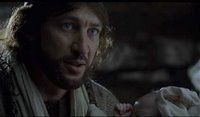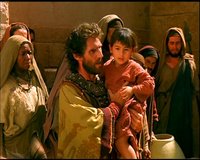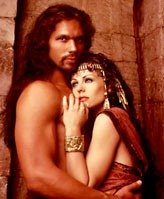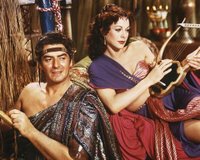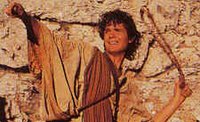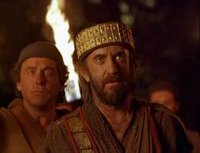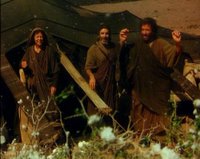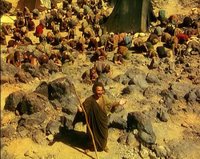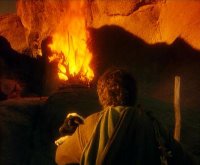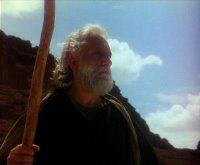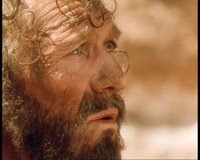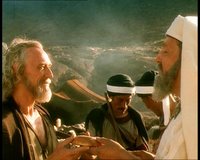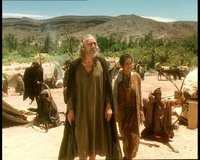 There have been numerous attempts in the last ten to fifteen years to use the book of Revelation as major source material for a screenplay. Predictably, most of the resulting films have landed somewhere between disappointing and just plain awful. The biggest weakness has generally been low production values. However, this has usually been bolstered by detached, futuristic, interpretations of John’s apocalypse in turn creating fictional scripts that speculate on how Revelation’s bizarre imagery will come to pass in “reality”. Unfortunately, this has sustained the impression many hold that Revelation is a bizarre, virtually impenetrable book, leaving those who feel uncomfortable with such alien end of the world scenarios disillusioned with John’s apocalypse altogether.
There have been numerous attempts in the last ten to fifteen years to use the book of Revelation as major source material for a screenplay. Predictably, most of the resulting films have landed somewhere between disappointing and just plain awful. The biggest weakness has generally been low production values. However, this has usually been bolstered by detached, futuristic, interpretations of John’s apocalypse in turn creating fictional scripts that speculate on how Revelation’s bizarre imagery will come to pass in “reality”. Unfortunately, this has sustained the impression many hold that Revelation is a bizarre, virtually impenetrable book, leaving those who feel uncomfortable with such alien end of the world scenarios disillusioned with John’s apocalypse altogether.It’s a relief, then, that Lux Vide’s The Apocalypse locates its story in the past, preferring to focus on John (played by the late great Richard Harris) and the group of churches in Asia he is responsible for. It is against this background that we see John (who is hiding under the pseudonym Theophilus) receive his visions. The task of covering 22 chapters of the biblical text, whilst building sufficient context around it is so huge that the producers wisely boil it down to its key components. For example, the film recognises the parallel nature of the seven seals / seven trumpets / seven bowls sequences, and wisely focuses, almost exclusively, on the first. By book-ending the film, and the main section of Revelation’s content, with abbreviated forms of John’s own bookends, the gist of the apocalypse is left largely in tact. This abbreviation process is also aided by focussing the non-visionary section of the film on just one of John’s seven churches, that in Ephesus.
The previous twelve films in Lux Vide’s ‘Bible Collection’ series were nearly all named after their protagonist. It seems strange, therefore, that they have not followed suit with The Apocalypse, particularly given the associations of poor quality filmmaking and the lunatic fringe such a title brings with it. As the film unfolds, it becomes clear that it is really about John. The non-visionary parts of the story actually take up the most of the film’s screen time.
So its no surprise that the film’s opening shot briefly introduces us to John, before jumping to Domitian’s announcement of his divinity and then to the Ephesian church. There we are introduced to Irene (who met John many years ago) and Valerius, who we soon find out is a Roman spy. Having worked his way into the church in Ephesus, his next mission is to infiltrate the group of Christians working in the mines of Patmos, where John himself is rumoured to be imprisoned. Domitian hopes that finding John and executing him, combined with a rigorous campaign of violence against the church in Asia, he will be able to stamp out the Christian faith altogether.
Inevitably there are also a few factual quibbles. For example, most scholars question whether the John who wrote Revelation was the same John who was one of Jesus’ original twelve apostles and the reign of Domitian has clearly been shaped to suit the overall narrative. However, this type of deviation is really just a by-product of disseminating the material for a wider audience, which the film does admirably well.
Where the plot really lets itself down is when it begins to deviate from its starting point, overcomplicating matters by introducing sub-plots of escape, power-struggles, pseudonymity and romance - not to mention the painfully inevitable conversion of Valerius. The two main aims of these sub-plots appear to be to add extra interest to the story, and to emphasise just how wise John was. The former falls flat on its face whilst the latter seems largely unnecessary, leaving little grounds for their inclusion.
The film’s other major flaw is its use of CGI. The film’s release has been delayed by two years and during this time CGI come on in leaps and bounds. However, even accounting for that, much of the CGI seems either forced, anachronistic or just poorly executed. The project’s demands are huge – alternating between realistic scenes on earth and supernatural scenes in heaven – and although it’s a worthy effort, the CGI is sadly not up to it. Hence, The Apocalypse is unlikely to be a film that cinephiles, theologians or historians embrace too closely (even though it embraces the style of interpretation favoured by most scholars).
It is to be hoped that such weaknesses can be forgiven by audiences because it is an important film. Artistic interpretations of the Revelation have almost always focussed on the bizarre aspects of the text. This has resulted in the book being gradually nudged towards the fringes of Christian belief where it is less of an embarrassment. Where this project excels is by locating the imagery in its original context so that potential applications of its message to 21st century Christianity can begin to emerge.
The film is an important starting point, turning back the clock on centuries of misinterpretation and over-active imagination. So whilst there are a few weaknesses and potential quibbles, its overall thrust should be loudly applauded.

.jpg)





.jpg)




